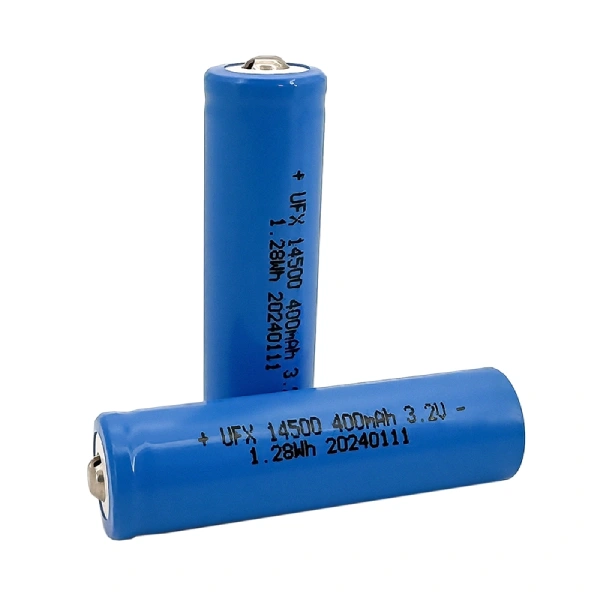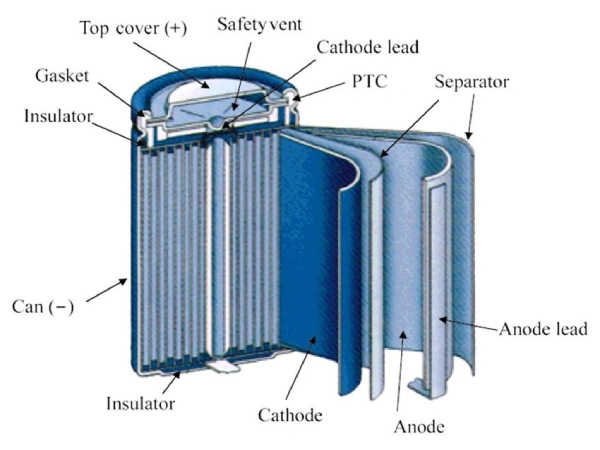Part 1. Cylindrical cell history
Cylindrical cells have a long history. Since the introduction of dry batteries, batteries have been cylindrical in appearance. The earliest cylindrical cell is the 18650 lithium battery invented by Japan’s SONY in 1992.
The market penetration rate is very high because the 18650 cylindrical lithium battery has a long history. Cylindrical cells adopt a fairly mature winding process with a high degree of automation, stable product quality, and relatively low cost.
However, with the development of the new energy industry and energy storage industry, battery types have gradually become more abundant. As a classic appearance type, the “cylindrical cell” has also evolved to a certain extent. 18650, 21700, 26650, and other types are gradually derived in power batteries.
Part 2. Cylindrical cell naming rules
The cylindrical cell production process is mature and appears relatively strict. Therefore, to distinguish its specifications and ingredients, there is a mature naming method. Their naming convention is usually based on size, shape, chemical composition, and other properties.
The following are the key points of some common cylindrical cell naming rules:
1. Size identification
The size of a cylindrical cell is usually expressed by its diameter and length. For example, the 18650 battery has a diameter of 18 mm and a length of 65 mm, with 0 referring to the cylindrical type.
2. Chemical composition identification
A battery’s chemical composition may also be included in its name. For example, lithium-ion batteries are often labeled Li-ion.
3. Battery type identification
The battery type may also be reflected in the name, for example, Li-Polymer.
4. Manufacturer’s identification
The manufacturer’s information is also usually included in the battery model number to distinguish products from manufacturers. Batteries like Ufine Battery all have the “UFX” logo.
5. Capacity identification
The capacity of a battery is usually expressed in milliamp-hours (mAh) or ampere-hours (Ah), which indicates how long the battery can supply power at a certain current.
For example, a typical 18650 battery might have the following designation: “18650 Li-ion 2500mAh”, which means it is a lithium-ion battery with a diameter of 18 mm and a length of 65 mm, with a capacity of 2500 mAh.
This is just an example of a general naming convention, and there may be some variations. When purchasing a battery, it is recommended to review the battery’s specification sheet and information provided by the manufacturer to ensure that the selected battery meets the specific application’s requirements.
Part 3. Cylindrical cell type
- 10440 battery
- 14500 battery
- 16340 battery
- 18650 battery
- 21700 battery
- 26650 battery
The types of cylindrical lithium batteries are described in detail in these articles.
Everything You Need to Know About Cylindrical Batteries
6 Battery Cell Types Comparison
Part 4. Cylindrical cell structure
The following is a common cylindrical cell structure; see the image below for details:
Ordinary cylindrical lithium-ion batteries consist of a casing, a cap, a positive electrode, a negative electrode, a separator, and an electrolyte. Generally, the battery casing is the battery’s negative electrode, and the cap is the battery’s positive electrode. The battery casing is made of nickel-plated steel plate.
The important difference between power cylindrical batteries is the conductive connection structure of the battery. A special high-current structure design is required because the general application current of power lithium batteries is relatively large.
1. Characteristics of cylindrical cell
Cylindrical cells are generally covered with steel or aluminum shells, and have a stable structure and high energy density. Cylindrical lithium battery cells are generally used in power batteries, such as the typical 21700 battery cells carried in the Tesla Model 3, which once made 21700 popular in the battery cell market.
However, cylindrical cells are not the only advantages; their shortcomings are also obvious. For example, the space utilization issue is criticized a lot. In the case of modularization, the cylindrical shape will cause a large waste of space, which is far inferior to the soft electric cells and square battery cells that are more conducive to stacking.
Below, we roughly summarize some of the advantages and disadvantages of cylindrical cells so that everyone can understand their characteristics more intuitively.
2. Cylindrical cell advantages
1) Higher energy density
Cylindrical cells usually have relatively high energy density. This means they can provide relatively large amounts of electrical energy stored in a relatively small volume. Generally, the rated energy density of a single-cell cylindrical lithium battery is between 300 and 500Wh/kg, and its specific power can reach more than 100 W. The actual performance of such products varies depending on the product models and specifications.
2) Good heat dissipation performance
Due to its cylindrical shape, the cylindrical cell has a relatively large surface area, which helps dissipate heat. This is critical for battery performance stability under high load or high temperature conditions. Of course, there is still a gap in heat dissipation performance compared to soft batteries. Soft batteries have a larger specific heat area. However, the soft battery case is relatively soft and can easily break and leak.
3) Longer life
First, cylindrical cell designs often provide a long cycle life, especially in rechargeable batteries. Secondly, the cylindrical cell production process is mature, the PACK cost is low, the battery product yield is high, the heat dissipation performance is good, and the service life is improved.
4) High stability
First of all, cylindrical batteries are generally sealed batteries, and there is no maintenance problem during use; secondly, the battery casing generally has high voltage resistance, and there will be no phenomena such as swelling of square and soft-packaged batteries during use.
3. Disadvantages of cylindrical cell
1) Low space utilization efficiency
The shape of the cylindrical cell may result in less efficient use of space inside the device, especially in some compact devices. Compared with square cells, cylindrical cells may leave more gaps when stacked, resulting in a waste of space.
2) Heavyweight
Compared with some other battery cell shapes, cylindrical cells may weigh more at the same capacity. This may not be suitable for some applications with high lightweight requirements. Especially for power batteries, it will increase the vehicle’s weight and affect the cruising range.
3) Poor plasticity
Compared with flexible cells, such as soft battery cells, cylindrical cells are relatively rigid in shape. Therefore, it may not be flexible under certain special design requirements. This poor plasticity makes the assembly method extremely fixed and lacks flexibility.
Part 5. Summary
The cylindrical cell is currently the most standardized and oldest battery cell type among battery cell types. Cylindrical cells are currently experiencing rapid development. Almost every once in a while, new cylindrical cell models will be iterated and become mainstream.
Regarding the development trend of cylindrical cells, higher energy density, better safety performance, and the exploration of new materials have always been the three mainstream directions of its development. The development of these trends has promoted the widespread application of cylindrical lithium batteries in various fields and allowed them to remain competitive in the changing market. In the future, with further technological innovation and the evolution of market demand, cylindrical lithium batteries are expected to continue to usher in more new development opportunities.
Related Tags:
More Articles

LiPo Battery Discharge Rate Guide & Calculation Tips
Understand LiPo battery discharge rates, C-ratings, and how to calculate max current. Essential guide for RC, drones, and electronics users.
High‑Capacity 3S LiPo Batteries: 5000 mAh vs. 10000 mAh
Compare 3S LiPo 5000mAh vs 10000mAh batteries by weight, power, and use. Find the best fit for your drone, RC car, or boat setup.
Top 5 Applications for Small 3S LiPo Batteries
Small 3S LiPo batteries power drones, RC gear, wearables, and robotics with high energy and low weight. Making them ideal for compact electronics projects.
Building and Charging Your Own 3S LiPo Pack: A Step‑by‑Step Guide
Learn how to build, balance, and charge a 3S LiPo battery pack safely at home with this complete DIY guide for hobbyists and beginners.
How to Choose the Right LiPo Battery Plug Type?
Discover the best LiPo battery plug types, how to choose them, and expert tips for safe usage, soldering, and maintenance.





